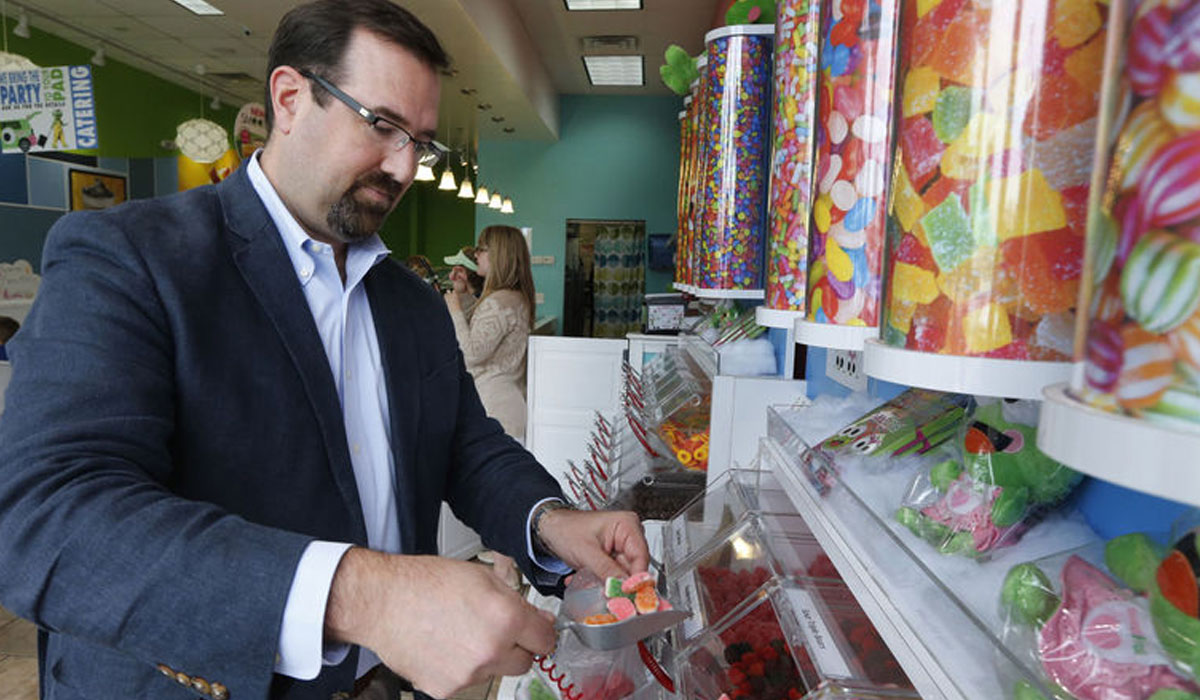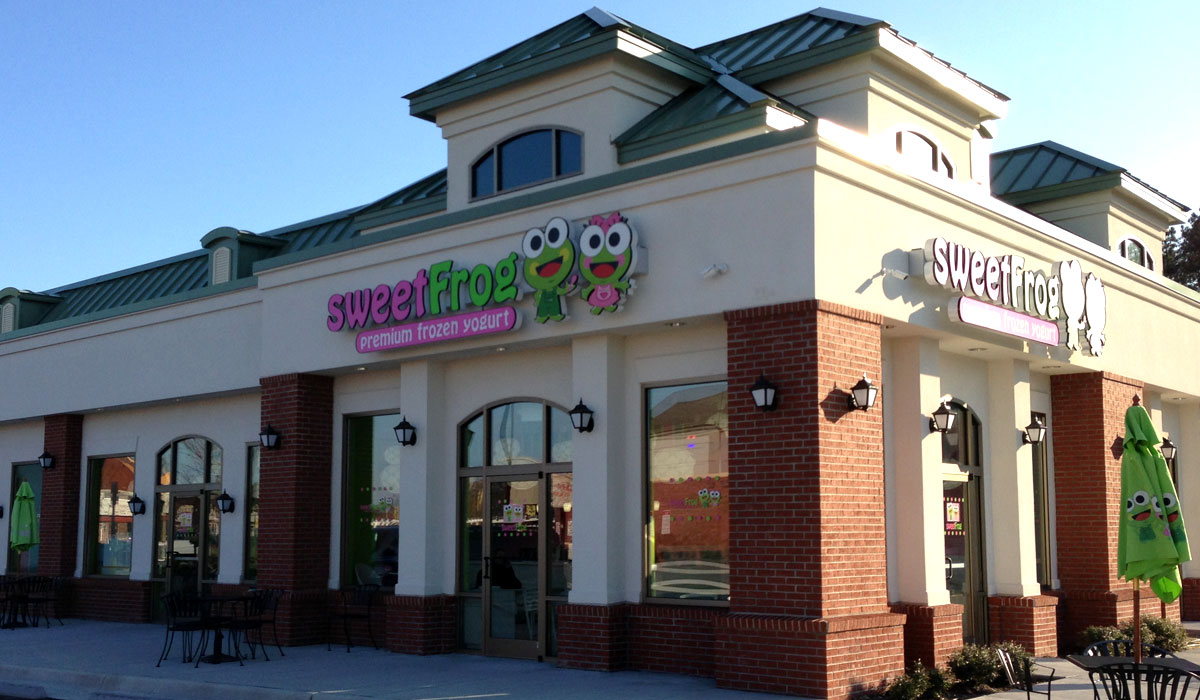EDITOR’S NOTE: In early September, MTY Food Group Inc., announced that one of its wholly owned subsidiaries signed an agreement to acquire most of the assets of the sweetFrog franchise system for about $35 million. The deal closed September 26. The subsidiary, Kahala Brands, features a portfolio of Cold Stone Creamery, Baja Fresh, Blimpie, and Extreme Pita. MTY also announced in February that it was purchasing the Grabbagreen franchise system for an estimated consideration of $2.75 million.
According to MTY Food Group, sweetFrog had done $92 million in sales the past 12 months before the deal.
Patrick Galleher and Boxwood Partners will continue to run 78 restaurants as a franchisee, the largest in sweetFrog’s system. They sold the brand and franchisor rights, but will still have 600 employees headquartered in Richmond, Virginia. The story below was written prior to the transaction.
To say the frozen yogurt industry is a crowded space would be a comical understatement. And sweetFrog CEO Patrick Galleher has seen a common thread start to weave throughout the booming segment. Start-up entrepreneurs are often lured by the seemingly elementary and clean structure of froyo shops, the lack of complex kitchens and need for double-digit employees to run shifts. “But I think the frozen yogurt industry ended up being a lot tougher for people than they originally thought it was,” he says. “There are definitely operators out there who thought the running of a frozen yogurt shop was going to be a hell of a lot easier than it ended up being. Keeping the store clean. Serving great product. Managing the supply chain. It is a lot tougher than people think it is.”
This reality is helping drive a growth strategy of sweetFrog’s surging operation. The 340-unit plus chain has taken an aggressive and focused rebranding and acquisitions approach to expansion, especially recently.
In May, for example, sweetFrog acquired five New York-based Hoopla Frozen Yogurt locations in Camillus, Middletown, New Hartford, Newburgh, and Poughkeepsie. By the end of the month, the stores were completely rebranded with new signage. Then, in July, sweetFrog took over two U-Swirl stores in Reno, Nevada. The chain made some subtle interior changes, as well as flipping the signage, and quickly had the stores up and running.
The strategy, which will remain key moving forward, aligns with Galleher’s background. He worked in finance and private equity, and led dozens of successful acquisitions as managing partner of Boxwood Partners, a merchant bank in Richmond, Virginia, including taking over sweetFrog in 2015.
“This is very similar to how banks grew during the 1980s and 90s, by rebranding local brands and buying community and local banks and making them into super regional banks,” he says. “So what we’re doing is trying to find really good smaller chains, or owner operators who can benefit from having a better brand, a better product, and better supply chain. We can almost instantly make a store perform better by buying it and turning it into a sweetFrog.”

“Information is the key to all businesses. And getting immediate feedback from the field, and customer experience is critical to making better decisions to improve that experience.” — sweetFrog CEO Patrick Galleher
In this case, the competition and relative uniformity of froyo shops nationwide is helping sweetFrog grow. Hoopla’s operators actually came through sweetFrog’s discovery day earlier in the year before deciding to open their concept.
Galleher was an investor and chairman of the board at sweetFrog from 2012–2015 before Boxwood Capital Partners purchased the controlling shares of the chain for an undisclosed amount. When Galleher originally invested in 2012, sweetFrog had just 36 locations. It ballooned to 340-plus in six years.
Galleher says they’d love to get over the 500 mark. There are currently 71 corporate stores and sweetFrog is looking to plant some along the I-95 corridor since the chain doesn’t have any from Palm Beach, Florida, down to Miami. They’re also targeting some corporate growth in the Dallas-Fort Worth market.
Galleher says the company-run footprint is important for a couple of reasons. One, the chain is open to buying back locations if an owner isn’t delivering sweetFrog’s brand promise. “We’ve proved very successful on turning around many locations after we’ve bought them back,” he says.
Also, sweetFrog has an aggressive testing schedule that includes quarterly taste testing of new flavors and recipes at its corporate units. In June 2017, sweetFrog expanded its menu with the launch of Dole Whip, a product made famous in amusement parks. About 85 percent of stores feature smoothies. And there were some tests that didn’t hit, like donuts and custard.
There’s plenty of room to grow corporately and through franchising, Galleher adds. SweetFrog has only five locations in California and, he says, the brand could easily have 200. “We haven’t done a ton of international development, either,” he says. “But we continue to evaluate as new opportunities come across. We still have a ton of opportunity.”
As for what’s working for sweetFrog, and how it’s thriving in such a dynamic field, Galleher credits customer sentiment, community, and a unique flavor profile as the main culprits.
He receives every online review, Yelp, Facebook, Google, and so on, in real time.
“Information is the key to all businesses. And getting immediate feedback from the field, and customer experience is critical to making better decisions to improve that experience,” he says. “You’re always occasionally going to have a store that’s dirty after 14 kids come through the toppings bar. There’s no way to make sure that it’s 100 percent spotless for every customer when you’re as busy as we are. But you’ve got to make sure you’ve got the processes in place to keep it as clean as possible all the time.”
SweetFrog, as the name suggests, makes a product that’s slightly sweeter than other brands. West Coast froyo chains tend to skew a bit tarter.
“We want to be more kid friendly,” Galleher says. “We want to be more competitive to ice cream versus other frozen yogurts.”
The other part of sweetFrog’s name—the “frog” half—stands for “fully rely on God.” Beyond how that might appeal to religious operators and customers, Galleher says, sweetFrog’s community-first approach to business is a key differentiator. SweetFrog hosts Leap Forward School programs that provide schools “a unique way to encourage students to reach greater heights,” the company says. This includes working with schools to offer free frozen yogurt cards for faculty to use in rewarding students. The company also teams with teachers to develop educational field trips. The sweetFrog “Leap Froward Field Trip Kit,” includes worksheets and hands-on activities that teach students about weight, temperature, mass, volume, graphing, currency, and more.
There’s also a sweetFrog badge and patch program with the Girl Scouts that takes children on a behind-the-scenes tour.
“The way execute that on a day-to-day basis is we really want to be part of the community. We want to make sure families feel like they’re going to safe, clean, friendly environment. We really want to make sure that local PTAs and local church groups feel like they can do fundraisers with sweetFrog in a safe environment,” he says. “We really want our owner/operators to be involved in the communities, and not just another retail food establishment.”









